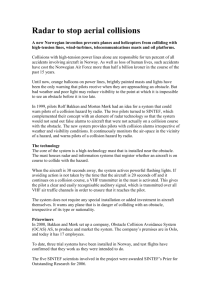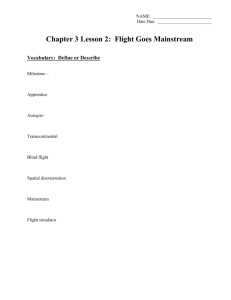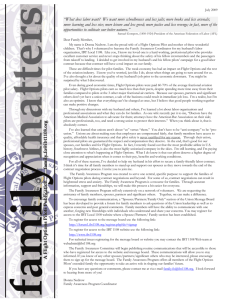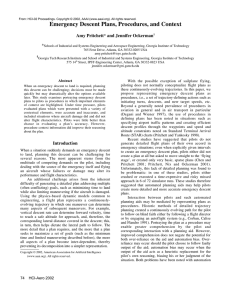Human Factors in Formation Flights for Air Cargo Delivery Jean -
advertisement
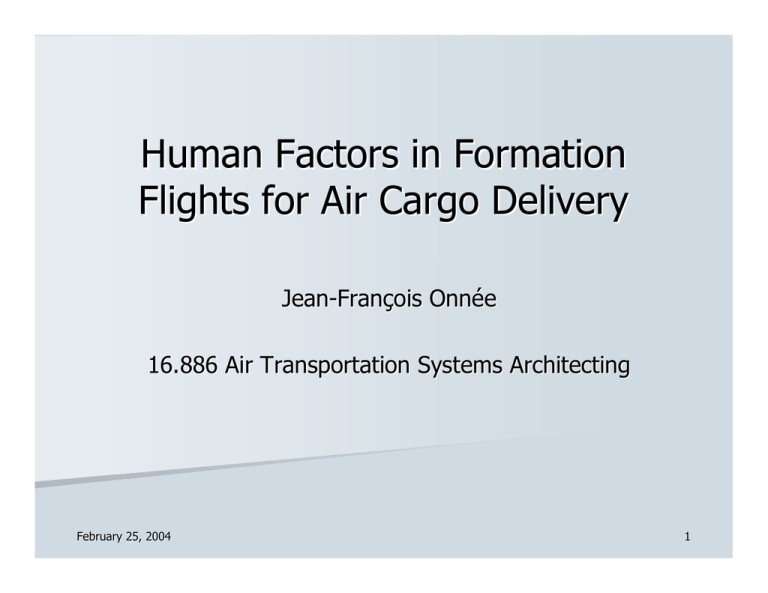
Human Factors in Formation Flights for Air Cargo Delivery Jean-François Onnée 16.886 Air Transportation Systems Architecting February 25, 2004 1 Overview of the task and drivers The goal of this study is to help determine the place that man should hold in the execution of a formation flight for cargo delivery. Main underlying issues: – – – – Are pilots needed on board these aircraft? Are they needed in every plane? What do their exact tasks consist in? What should the interface between the pilot and the machine look like? What aspects are going to drive this study? – The mission itself – Human capabilities from a physiological and cognitive point of view and the related consequences February 25, 2004 16.886 – Human Factors 2 Mission For a military tactical mission: – Need for flexibility: each airplane of the formation is likely to be assigned a different mission once the destination is reached. – Large UAV’s could take part to the formation (e.g. Boeing’s Predator) February 25, 2004 16.886 – Human Factors 3 Mission For a commercial mission – Having a rigid formation of airplanes taking off from the same location and bound for the same destination may be done automatically. – A formation working like a sky version of the “Greyhound Bus Service” requires a lot of flexibility that is not always achievable by a fully automated system. February 25, 2004 16.886 – Human Factors 4 Physiological and cognitive aspects and their consequences. These points are directly connected to the workload of the pilot i.e. the distance between airplanes. Positive aspects: – Vortex effects on F/A-18 require pilots action that are within their capabilities (source: NASA) – Fair pilot reaction time (between 1 and 2 sec.) (source: AIAA) – Flight trainers is an efficient way to prepare pilots to flying in formation and improving their control over the aircraft. (source: G.B.Reid) It shows the potential a pilot has to react and avoid a collision from happening February 25, 2004 16.886 – Human Factors 5 Physiological and cognitive aspects and their consequences. Negative aspects – Pilots actions result in an increase of the fuel consumption: – Continuous concentration capabilities are limited to 30 minutes (source: aeromedecine.fr) – Spatial disorientation is a phenomenon that can lead to mishaps (source: NAMRL) – Human errors account for 70% of accidents and incidents in 2001 (source: Université Paris-5) February 25, 2004 16.886 – Human Factors 6 Physiological and cognitive aspects and their consequences. Possible tradeoff: – Implementing an avionic equipment that alleviates the pilots’ workload by providing them with information about the probability of a collision could help them decide when to resume control of the aircraft commands. It should also help them when flying at night or under IMC without auto-pilot. Constraints: – The device should not require a high and persistent level of concentration. – It should be reliable enough to avoid false alarms, which would result in a fuel consumption increase. February 25, 2004 16.886 – Human Factors 7 Physiological and cognitive aspects and their consequences. – That device should be sensory compatible to avoid spatial disorientation problems. Head Mounted Display equipments stand as an example. Source: NAMRL – Part of the display could be inspired from the concept of Tunnel-in-the-sky and show the region in which the pilot should operate the aircraft to have a maximum reduction of the induced drag, when autopilot is off. February 25, 2004 16.886 – Human Factors 8 Physiological and cognitive aspects and their consequences. Example: High risk of collision Low risk of collision This system could be assisted by alarm sounds Situation of the plane The challenges linked to an efficient design consist in providing the pilots with accurate information but also predictions. -This device is based on the capability to simulate under uncertainties. How well do we master this field? -How well can a vortex submitted to weather conditions be modeled? February 25, 2004 16.886 – Human Factors 9 Other issues Developing a fully automated system can also have a socio-cultural impact. Would you trust such a system? February 25, 2004 16.886 – Human Factors 10 Future work needed – Further studies to assess the workload and the physiological aspects of pilots flying a formation of civil aircraft. – A more in-depth study on an avionic equipment that could help reduce the pilots’ workload. – If airplanes are only controlled from the ground, what should the interface with man look like? – What is the state of the art in automation ? What can machine do better and more reliably than man? February 25, 2004 16.886 – Human Factors 11 Acknowledgements and References Missy L Cummings, Boeing Associate Professor, Massachusetts Institute of Technology. F/A-18 Performance Benefits Measured During the Autonomous Formation Flight Project by J.Vachon, R.J.Ray, K.R.Walsh & K.Ennix, NASA, September 2003 Induced Moment Effects of Formation Flight Using two F/A-18 Aircraft by J.L.Hansen & B.R.Cobleigh, NASA, August 2002 Conflict between the Human Sensory System and Cockpit Design Standards by F.Patterson NAMRL Visual, Cruise Formation Dynamics by S.Houck & J.D.Powell, Stanford University, 2000. Effects of Preview, Prediction, Frame of Reference, and Display Gain in Tunnel-in-the-Sky Displays by S.Doherty of ERA University & C.D.Wickens of ULUC, 2001 Training Transfer of a Formation Flight Trainer by G.B.Reid, Air Force Human Resources Laboratory, 1975. http://membres.lycos.fr/belldandy/aeromedecine.html http://www.math-info.unive-paris5.fr http://www.boeing.com February 25, 2004 16.886 – Human Factors 12


